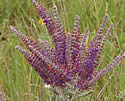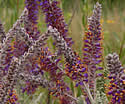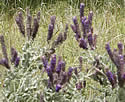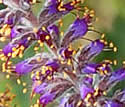Amorpha canescens (Lead Plant)
| Also known as: | Shoestrings |
|---|---|
| Genus: | Amorpha |
| Family: | Fabaceae (Pea) |
| Life cycle: | perennial woody |
| Origin: | native |
| Habitat: | sun; dry prairies, sandy open woods |
| Bloom season: | June - August |
| Plant height: | 1 to 3 feet |
| Wetland Indicator Status: | none |
| MN county distribution (click map to enlarge): |  |
| National distribution (click map to enlarge): |  |
Pick an image for a larger view. See the glossary for icon descriptions.
Detailed Information
Flower: 


![[photo of flowers]](/udata/r9ndp23q/pd/amorpha-canescens-9837-1-t.jpg) Dense spike clusters 2 to 6 inches long of many small flowers with protruding bright orange-tipped stamens. Individual flowers are less than ¼ inch long with a relatively broad upper petal that wraps around the stamens creating a tube, then flattens out after pollination. Color ranges from light purple to deep blue-violet. One plant typically has 5 or more spikes at the end of branching stems, the terminal spike being longer than the surrounding spikes. Flowers bloom from the bottom of the spike up.
Dense spike clusters 2 to 6 inches long of many small flowers with protruding bright orange-tipped stamens. Individual flowers are less than ¼ inch long with a relatively broad upper petal that wraps around the stamens creating a tube, then flattens out after pollination. Color ranges from light purple to deep blue-violet. One plant typically has 5 or more spikes at the end of branching stems, the terminal spike being longer than the surrounding spikes. Flowers bloom from the bottom of the spike up.
Leaves and stem: 

![[photo of leaves]](/udata/r9ndp23q/purple/lead-plant_0701_101513-t.jpg) Compound leaves may have as many as 50 leaflets. Each leaflet is about ¾ inch long and is generally oval to egg-shaped, rounded at both ends. Leaves are covered in fine white hairs, giving them a woolly grayish appearance. Main stems are brown and woody; the few branching stems are typically grayish green from fine white hairs.
Compound leaves may have as many as 50 leaflets. Each leaflet is about ¾ inch long and is generally oval to egg-shaped, rounded at both ends. Leaves are covered in fine white hairs, giving them a woolly grayish appearance. Main stems are brown and woody; the few branching stems are typically grayish green from fine white hairs.
Fruit: 
![[photo of fruit]](/udata/r9ndp23q/pd/amorpha-canescens-seed-6-t.jpg) Fruit is a densely hairy pod with the remains of the pistil at the top. The pod contains a single seed.
Fruit is a densely hairy pod with the remains of the pistil at the top. The pod contains a single seed.
![[photo of seed]](/udata/r9ndp23q/pd/amorpha-canescens-seed-5-t.jpg) Seed is a smooth brown bean less than 1/8 inch long, oval with a slight hook at the tip.
Seed is a smooth brown bean less than 1/8 inch long, oval with a slight hook at the tip.
Notes:
Lead Plant tends to grow in clumps. According to one of my field guides, Lead Plant can live for centuries and not grow larger than 3 feet tall. Technically a shrub, the woody stems usually persist through winter but may die back and resprout in spring. The woody stems are also removed by fire but this species has very deep roots and survives fire well. It has its place in the backyard garden, the foliage and flower spikes both add interest. It is overall similar in appearance to Silky Prairie Clover (Dalea villosa) but the latter has more pinkish flowers with yellow stamens, fewer leaflets per compound leaf and its stems are densely covered in woolly hairs and are not woody.Native Plant Nurseries, Restoration and Landscaping Services ↓
More photos
 clump of Lead Plant with Butterfly-weed and Black-eyed Susan
clump of Lead Plant with Butterfly-weed and Black-eyed Susan more plants
more plants Lead Plant in oak savannah
Lead Plant in oak savannah  more flowers
more flowers
Photos by K. Chayka taken at Long Lake Regional Park, New Brighton, MN. Photos courtesy Peter M. Dziuk taken in Anoka county.
Comments
Have you seen this plant in Minnesota, or have any other comments about it?
on: 2008-06-08 17:26:28
You've helped me to name another plant. I took a picture of a lead plant by a pond in Waite Park on one of my walks last year. Waite Park is in Stearns County.
on: 2010-07-22 14:14:13
I just noticed a new plant along the road, in between ours & the nieghbors' property, near the Gull Lake Dam. Great website, I found the flower right away!
on: 2010-07-25 13:53:18
I think there are a bunch of these at the Maple Grove mall area. They're being used in flower arrangements. I took a photo and I've been trying to find out what it is.
on: 2011-06-14 19:53:13
I have seen this by the lake in town and didn't know what they were. They are so beautiful. I love this website. Thank you so much for such a great resource!
on: 2013-10-21 09:57:41
This plant grows in profusion in the open areas of the Nature Conservancy preserve just east of St. Peter.
on: 2014-07-23 21:48:07
Blooming in great profusion on July 20
on: 2014-07-29 07:04:32
Saw this blooming July 26 at the Leo Rudolph Nature Preserve in Owatonna. What a stunning plant! Just beautiful!
on: 2015-07-12 17:19:35
Around Big Sandy lake I found one isolated plant. Very pretty and stands out against the background flora
on: 2015-08-22 09:14:14
August 8, 2015
on: 2017-06-08 17:10:05
Is it possible for one of these to get to be six feet tall and Wide? I am 99 per cent sure that this is what is growing on the shoreline of a small island that is part of our property. Flowers, leaf type. Pea type compound leaves and purple and orange flowers with raceme structure. Blooming now..June 2017.
on: 2017-06-08 17:29:28
Carol, lead plant is a dry prairie species and rarely gets much over 3 feet tall. It's much more likely you're seeing the related Amorpha fruiticosa. Lakeshores are its primary habitat.
on: 2017-07-01 21:01:08
Found a huge plant...easy 3 feet tall...main trunk was close to 1/2 inch diameter...today is July1...blossoms are really close to forming.
on: 2018-06-14 13:09:51
Some are blooming now (early June) off Rice Creek North Trail in Ramsey County.
on: 2018-06-21 13:38:36
Deer resistant? Pollinator? Bird/butterfly friendly?
on: 2018-07-18 04:51:18
Al-SE MN Answer to your questions, yes. I have this growing is dry sandy dense soil. No care. Lots of deer and have never seen anything eat it.
on: 2019-06-23 18:37:20
Growing, not yet blooming. In lily's preserve. Part of Dodge nature center, we believe she and lily may have been friends(?) The plant is in the open along with not yet blooming butterfly plant and blooming black eyed Susan's. We will need to go back soon to see flowers.
on: 2020-05-28 21:47:23
I tried growing this plant in my "wild" garden. I love it but so do the bunnies!
on: 2021-06-12 10:56:23
Could this plant be planted in the area of Orr MN in St Louis County and not considered "invasive"? According to the map, it grows nearby but does not grow in this area so I wanted to check to see if would not be recommended.
on: 2021-06-12 15:20:07
Serena, lead plant is not invasive anywhere in MN. It will grow if you have the right soil conditions, preferably dry and sandy in full sun.
on: 2021-07-11 07:16:16
Yesterday morning I noticed this plant looking very out of sorts on a hike in the woods next to Lake Rebecca. I took a photo and posted it on my Instagram. Last night, I went on a beautiful sunset horseback ride in the Crow Hassan Park Reserve. I immediately recognized it blooming all over the prairies looking much more at home in the sun filled fields. Thank you for helping me identify it! The leaf structure is especially beautiful. Crow Hassan has very dry and sandy soil July 10th, 2021
on: 2021-07-18 07:30:59
Saw one clump of lead plant blooming well in Grand Beach Provincial Park. Just sending this to you for your interest. Love your website.
on: 2022-05-13 09:48:32
How can I distinguish between lead plant and crown vetch new growth? We are restoring a prairie, and burned this spring. We know we have a good supply of lead plant but also crown vetch. I want to get to the crown vetch shortly after it starts to leaf (to minimize any other plant impact) but worry I may be getting lead plant sprouts. Any suggestions?
on: 2022-05-13 10:11:39
Annie, leadplant has woody stems and hairy leaves; crown vetch has neither of those.
on: 2022-08-07 05:06:20
Living in the valley by the Buffalo River has given me the opportunity to enjoy so many varieties of plants. This one grows along the ditches and backyard
on: 2022-08-08 17:00:16
My prairie garden borders the Mississippi River. It was installed 15 years ago. In July I found a couple Lead Plants. Maybe they have been growing years before, but it is the first time I came across them. Very exciting.
on: 2023-07-15 14:17:55
I think this is the plant along the north side of the Sakata Singing Hills bike trail, just before you enter the park from the Morristown side. Growing in a very sunny location along with an orange flowering plant either Indian paintbrush or butterfly weed.
on: 2023-07-16 10:30:28
Hi there: When is the best time to plant lead plant?
on: 2023-07-16 13:48:03
Gary, I don't know about leadplant specifically, but if you're planting seed fall is generally the best time since many species require a period of cold-moist stratification before their seeds will germinate. Otherwise, check with wherever you obtained the seeds/plants for their guidance.
on: 2023-09-21 11:37:17
Touch the sky Prarie. It's not blooming ofcourse but the leaves are a dead giveaway. Should come a few weeks ago.






